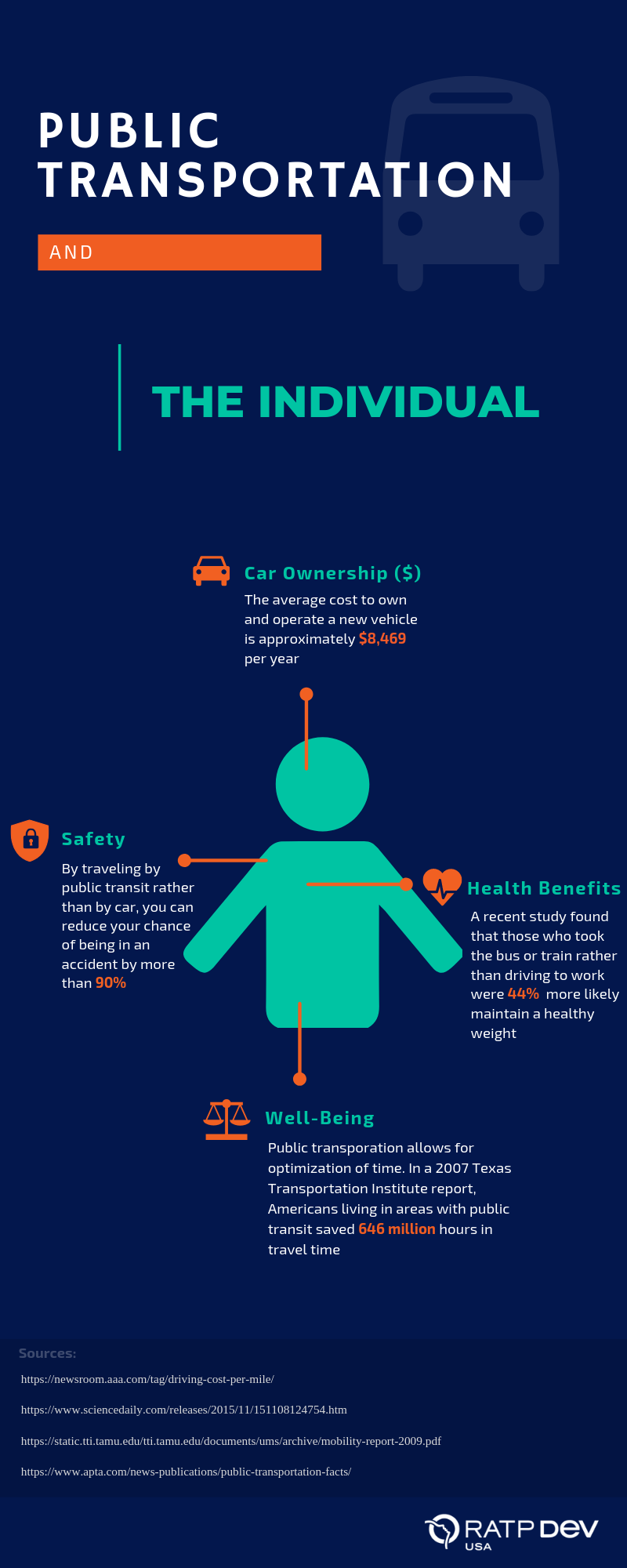In our previous post, we talked about the ways in which public transportation helps the community at large, how it is environmentally responsible and economically rational. Today, we want you to consider the benefits of public transportation on your wallet and even your mind and body.
Cost of Car Ownership
Owning a car can be an expensive responsibility. There are all kinds of expenses associated with car ownership: fuel, maintenance, repairs, insurance, licensing, registration, taxes, as well as the costs associated with loan interest and depreciation. The American Automobile Association estimates that, taking all those things into account, the average cost to own and operate a new vehicle is approximately $8,469 per year. If you drive 15,000 miles a year and pay approximately $2.52 a gallon at the pump, the Washington Post estimates that every mile you drive costs you an additional 59 cents. But there are more than just dollar amounts associated with car ownership, there are also non-monetary hassles such as finding and paying for parking, digging out your snow-buried car after a winter storm, or having to deal with a car that unexpectedly experiences a mechanical failure in the middle of a trip. You can see how quickly the costs add up.
Health Benefits
According to the Florida Public Transportation Association, public transit users are more likely to meet recommended exercise goals than those who opt against public transport use. That assertion is based on a recent study in Osaka, Japan which found significant health benefits associated with public transportation, stating that those who took the bus or train rather than driving to work were:
44% less likely to maintain a healthy weight,
27% less likely to have high blood pressure, and
34% less likely to have diabetes.
The reason is simple: public transit users tend to walk more than their non-transit counterparts. According to the American Public Transportation Association, more than two-thirds of transit users walk to their stop or station. Those daily walks are an ideal and convenient way of meeting the exercise goal set by the CDC, which recommends that adults get at least 150 minutes of moderate intensity aerobic physical activity a week.
Personal Well-Being
We all wish we could have a few mores hours each day to get things done. In a 2007 Texas Transportation Institute report, Americans living in areas served by public transit saved 646 million hours in travel time. Just imagine what you could do with all that time rather than sitting behind the wheel of your car, staring at the car in front of you while fuming at the traffic congestion between you and your destination. Leaving the driving to someone else is just less anxiety provoking, don’t you think?
Besides, public transportation allows for the optimization of time. Riding the bus or the train frees up substantial amounts of time and attention that you can devote to something else. It allows to you successfully and safely multitask. You can commute while texting your friends, finishing a work project, reading a magazine or newspaper article, or dare we say it, watch that cat video your friend sent you. (Hey, studies have found that people who watch cat videos are more productive at work!) You can download a new podcast, listen to a new band, check out the scenery and any new local stores or restaurants that have opened in your neighborhood, people watch, or even meditate.
If you’re feeling gregarious, the bus or the train is a great place to expand your social circle. Talk to the person in the seat next to you. You might learn something new, find out you have something in common, or perhaps even discover a new job opportunity. Mass transit is inherently democratic in that it is equally accessible to everyone: people with disabilities, senior citizens, commuters, and young people. You never know who you’ll meet on the bus, so say hello and break the ice. As Humphrey Bogart said in the last line of Casablanca, it might be “the beginning of a beautiful friendship.”
Did you know?
Public transit is safer than travelling by car. According to the APTA, public transit trips are ten times safer per mile than trips by car. The Association notes that by traveling by public transit rather than by car, you can reduce your chance of being in an accident by more than 90%. In fact, the Federal Transit Administration reports that public transportation is one of the safest ways to travel in the United States.
Public Transit is Evolving
Sure, there are perceived tradeoffs when taking the bus or train. At first glance, car trips seem more convenient and require limited planning in advance, unlike mass transit which requires you to travel on its schedule. However, as public transit continues to evolve and adopt technological innovations, those tradeoffs are disappearing. For example, transit apps and improved signage at stops and stations give riders real-time information about vehicle arrival times. Moreover, agencies are improving their scheduling algorithms to reduce the wait time between vehicles. Ride-share and first mile / last mile options are popping up all over the country, making it easier for riders to get to and from public transportation.
Overall, public transportation is less expensive than car ownership, it can help improve your health, it’s an incredibly safe way to travel, and it can give you back time in your day. Why wouldn’t you hop aboard? We hope to see you soon, on one of our many public transit systems in the US!

- Sustainibility